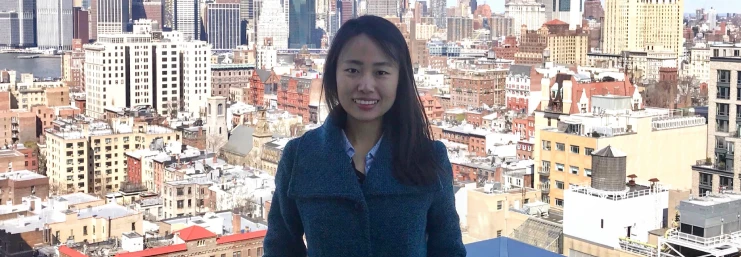
In 2014, she was struggling to find work in New York. Now, Xueyan Zheng incorporates her knowledge of chemistry, material sciences, and architecture to help design some of the city’s newest buildings.

In 2016, Xueyan Zheng was part of a team of architects meant to accomplish one task: restore the Standish Arms Hotel with injections of modernity and transform it into a luxury condominium. The highly anticipated end product received attention from Forbes magazine, Curbed architecture blog, and countless other news outlets. The Standish, as it came to be renamed, eventually had celebrities like Matt Damon and John Krasinski flocking to the property to claim a new home. With Ms. Zheng’s contributions, The Standish’s crumbling, aged aspects were expertly restored while maintaining its historical appeal. But Ms. Zheng’s career didn’t start with flashy projects or celebrity names.
Ms. Zheng grew up in the small town of Shouyang, China. Developing an early interest in math and physics, Ms. Zheng was filled with an insatiable curiosity for the wider world. As a child, her dream was to explore space as an astronaut, and as she grew, the desire to step beyond her boundaries fueled a lifelong mission: to reimagine the world around her. Ms. Zheng dreamt of beginning a career in one of the world’s biggest cities, where she could be at the forefront of creativity and innovation.
Unfortunately, the Chinese education system was structured in a way such that only the very best students were awarded with the choice of college and major. So, Ms. Zheng forfeited her choice of major and ultimately began to study pharmacy, temporarily putting her dreams aside. But with the efforts and ambitions of her academic career, Ms. Zheng continued her studies at Virginia Tech, this time in chemistry. By the time that she had set foot in America, Ms. Zheng knew that New York City was the place she needed to be.
“I had always seen New York’s amazing buildings and heard of the big architectural firms,” said Ms. Zheng. She envisioned a career in architecture, where she could apply her knowledge in the material sciences to help design soaring skyscrapers that she had once only seen on TV.
However, beyond the gates of Virginia Tech awaited the ominous hurdle of employment. When she arrived at the Big Apple, she had no job experience in architecture. Furthermore, her employment authorization would expire in three months, at which point she would be required to leave the country. Her only hope was to find a job quickly, though it meant that her employer would have to go through the arduous process of sponsoring her for an employment visa. While scrambling for a job, Ms. Zheng worked as an unpaid intern at a small architecture firm of two employees, hoping to be able to expand her portfolio and be recruited elsewhere.
“I couldn’t stop having scary thoughts,” Ms. Zheng recounts. She notes that period as being one of the darkest points of her life. “I was constantly out checking for jobs and revising my portfolio.”

Finally, after a nerve-wracking two months, Ms. Zheng secured a job at a mid-size architecture firm. After two years, Ms. Zheng’s work there caught the eye of SLCE Architects, one of the biggest architecture firms in New York. Since then, her incredible inner drive and strong sense of motivation has only continued to advance her career.
“I believe that I am learning something new every day, and I get out of bed knowing my portfolio is getting one step closer to the next big project,” she says.
Ms. Zheng’s dream is to be the head of her own architectural firm. By her own analysis, the usage of “old fashioned” materials such as concrete and stone are not sustainable and ultimately go to waste when the buildings are torn down. With her expertise in both the material sciences and architecture, Ms. Zheng hopes to develop a new generation of buildings and materials that are sustainable, eco-friendly, and ethical in construction.
“I want to look to the future with my projects,” she says.
She is currently following the development of The Silk Pavilion at MIT and estimates that smaller structures like gazebos and smaller houses may be able to implement that technology in as early as 10 years.
Ms. Zheng also said that she hopes for her firm to be a beacon of hope and optimism for immigrants to follow. She cites the privilege of being able to come to the United States and form a career for herself out of nothing, and wants to continue the cycle of the “American Dream” for the next generation of Americans.
“I want to be good to my employees and support their dreams and goals at my firm,” she said. “In doing so, I hope they’ll be able to take risks and try new things.”
